Mounds Share a Common Source
Updated September 2023
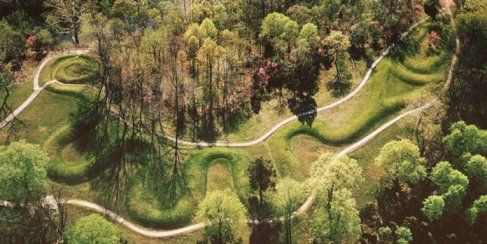 Serpent Mound, Adams County, Ohio, USASerpent Mound, Adams County, Ohio, USA |
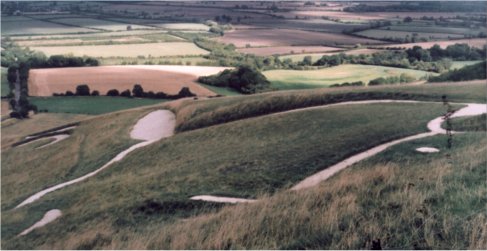 White Horse of Uffington, England ©Shannon DoreyWhite Horse of Uffington, England ©Shannon Dorey |
My research indicates that the people who built the Serpent and Lizard Mounds of Ohio had the same beliefs as those who built the White Horse of Uffington, Dragon Hill and other chalk mounds in England. The ancient religion that these two groups practised was associated with the alien Nummo and was the same religion known to the Dogon people of Mali, Africa. It is through the Dogon religion that we can connect these two groups of people.
The Dogon elder Ogotemmêli described the alien Nummo as being serpents with fish tails. They were primarily aquatic beings but they were amphibians and when they walked on land, they moved like serpents. They were described as standing on their fish and serpent like tails.Dorey, The Nummo p. 199 In other instances, he described them as being like lizards.
In their spaceship, which was associated with the Dogon Smithy and Granary, the Nummo Ancestors were depicted as Centaurs, with a human upper body and a horse for their lower body.Dorey, The Rose p.54
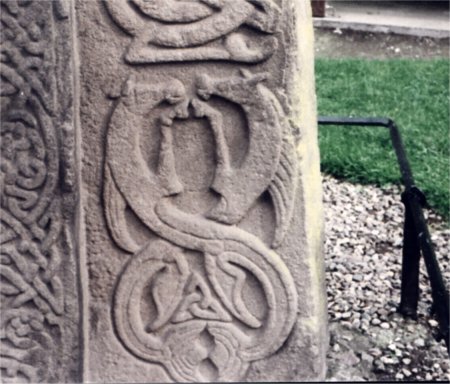 Twin Fish Horses on Aberlemno Stone Celtic Pictish Stone at Aberlemno, Scotland ©R. HillCeltic Pictish Stone at Aberlemno, Scotland©Robert Hill Cover of The Nummo |
This image from a Celtic Pictish stone in Aberlemno, Scotland shows the image of twin horses with fish tails connecting the image of the horse with the fish.Shannon Dorey, The Nummo, cover
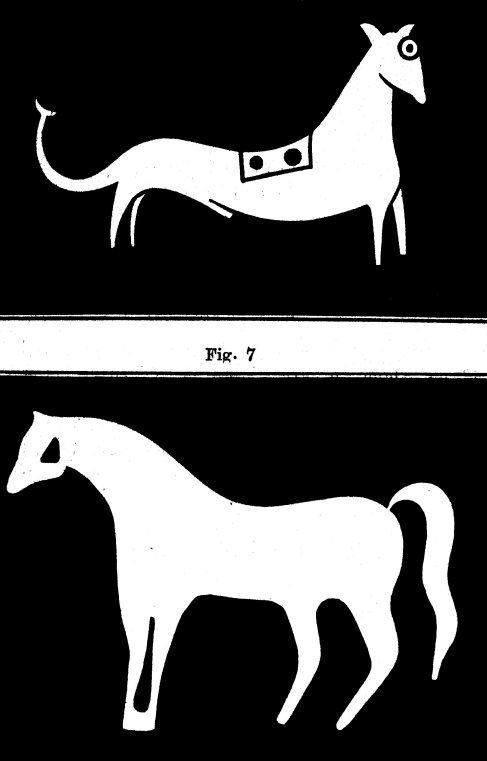 Westbury White Horse, 1772 (top) and 1778 (Bottom)Dorey, Day of the Fish p. 218 |
Chalk mounds in England also verify the horse-fish association. The Westbury White Horse is a hill figure found on the escarpment of Salisbury Plain, in Wiltshire. Located on the edge of Bratton Downs and lying just below an Iron Age hill fort, it is the oldest of several white horses carved in Wiltshire.
Rev. W.C. Plenderleath sketched the white horse in 1772 showing it with a serpent fish tail (shown above top). When the carving was re-cut in 1778 (shown above bottom), the fish tail was removed to depict a regular horse's tail, which is how it appears today.Shannon Dorey, Day of the Fish, pp. 218-219 The earlier drawing also shows a ring-eyed marking on the horse's face, which was associated with early Helladic bronze-smiths and the alien Nummo were known as "Heaven's Smiths".Shannon Dorey, Day of the Fish, p. 150
In Chinese and Celtic mythology, the fish-tailed horse image became identified with the dragon.Shannon Dorey, Day of the Fish, p. 212
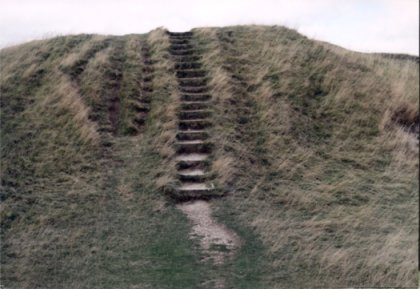 Close-up of Dragon Hill ©Robert Hill©Robert Hill |
Dragon Hill is located in the same area as the Horse of Uffington along with Wayland's Smithy in Oxfordshire. A bare patch of chalk is found on top of Dragon Hill where no grass will grow.https://en.wikipedia.org/wiki/Dragon_Hill,_Uffington Because of this, I believe this hill may have acted as a resting pad for the Nummos' travelling device. In the Dogon village, a field was left unseeded for the Nummos’ flying device because it affected the villagers’ crops. Ogotemmêli said the Nummos’ device could not “move out of the reserved territory” because it would scorch the millet and the village itself. Instead of using their flying devices, in areas where there were crops growing, the Nummo had to be carried on the backs of humans.
There was some suggestion the device was made of iron to protect the land from the flames it emitted. According to Ogotemmêli, iron was “the colour of shade,” and the sandal the Serpent wore to move about was made of iron because iron protected the soil from “feet of fire”.Shannon Dorey, The Master of Speech, pp. 22-23 I believe that this fire may be how the Nummo became identified with fire breathing dragons. It is possible that Dragon Hill was used as a resting place for the Nummo's spaceship or "Smithy" or possibly their "iron sandal" that emitted fire and allowed them to fly over land.
A later legend associated with Dragon Hill, probably originating in Christianity, reported that it was on this summit that Saint George slew the dragon, and the area where nothing grows is purported to be where the dragon's blood spilled.https://en.wikipedia.org/wiki/Dragon_Hill,_Uffington
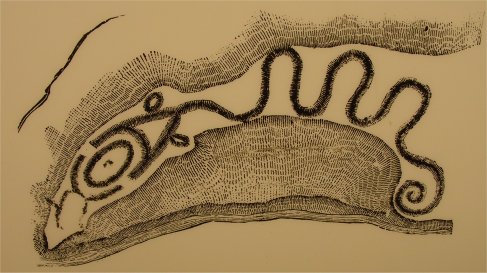 Engraving based on Serpent Mound sketchDorey, Day of the Fish p. 222 |
Since the fish tailed Nummo were also identified with serpents, I believe that the Serpent Mound located along Ohio Brush Creek in Adams County, Ohio is another depiction of the Nummo. The image is thought to represent a serpent eating an egg. Some scholars believe that the oval symbolizes the Sun, which would fit with Dogon mythology.Shannon Dorey, The Nummo, cover This represents the swallowing myth that is so much a part of the Dogon religion.Shannon Dorey, Day of the Fish, p. 224
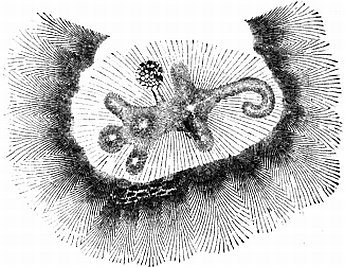 Lizard or Alligator Mound from Granville, OhioShannon Dorey, Day of the Fish p.225 |
The Nummo were also referred to as "the lizard" and the less known Lizard or Alligator Mound in Granville, shown in the above sketch, is described in this passage.
.Ephraim George Squier and Edwin Hamilton Davis surveyed the privately held site in Granville, Ohio for the Smithsonian Institution and reported their findings in their 1848 publication Ancient Monuments of the Mississippi Valley. They described the site as "strange." They report the location of the work as being 150 to 200 feet in height. They note that people in the area called it "the alligator," "although the figure bears as a close resemblance to the lizard as any other reptile." The head of the effigy points towards the southwest. The work totaled 250 feet in length from head to tail. The body was noted at 40 feet wide, and each leg was measured at 36 feet.Dorey, Day of the Fish p. 219
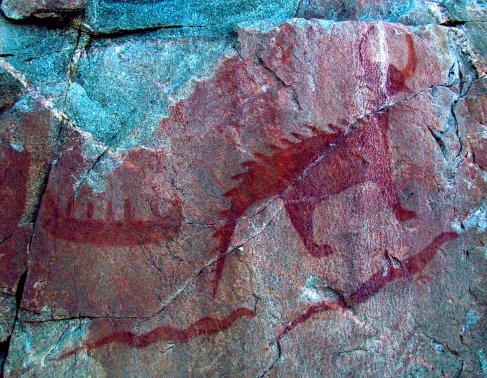 Pictograph of Mishipeshu or Mishibijiw By D. Gordon E. RobertsonBy D. Gordon E. Robertson - Own work, CC BY-SA 3.0, https://commons.wikimedia. org/w/index.php? curid=15941023 Shannon Dorey, Day of the Fish p.225 |
In 2003, archaeologist Brad Lepper suggested that the Alligator or Lizard Effigy Mound in Granville, Ohio represents the underwater Ojibwe panther Mishipeshu or Mishibijiw. It is one of the most important of several mythological water beings among many indigenous peoples of the Northeastern Woodlands and Great Lakes region, particularly among the Anishinaabe. Mishipeshu translates into "the Great Lynx". It has the head and paws of a giant cat but is covered in scales and has dagger-like spikes running along its back and tail. Above is a pictograph of a Mishibizhiw as well as two giant serpents and a canoe, from Lake Superior Provincial Park, Ontario, Canada. Attributed to the Ojibwe.Dorey, Day of the Fish p. 219
These descriptions are particularly important as they associate this figure with the Nummo Ancestor Lébé from the Dogon religion. Lébé had a fish tail but a human upper body and was symbolized by a lion. Because of her/his fish tail, Lébé was perceived as being physically challenged or "lame", and in The Nummo, I associate Lébé with the Celtic god Lugh Llew Llaw Gyffes, who was also "lame", and was known as 'the Lion with the Steady Hand'. In The Rose, I refer to the fact that the Cumbric word llewn associated with Lugh Llew Llaw Gyffes meant lynx in an ancient language related to the Celtic Welsh.Shannon Dorey, The Rose, p. 296 I also associated Lébé with the Greek Dionysus, whose name Robert Graves believed meant "The Lame God of Light."Shannon Dorey, The Nummo, p. 12 Dionysus' symbolic animal was the panther, showing a common theme in all of these Ojibwe descriptions. The panther was a sacred animal in the Dogon religion and one of the animals considered immortal.Shannon Dorey, The Rose, p. 362
Mishipeshu or Mishibijiw is also commonly referred to as the "Great underground wildcat" or "Great under-water wildcat," and is the most important of the underwater animals for the Ojibwa. Besides being an aquatic being, Lébé was also described as living underground.Dorey, Day of the Fish p. 220
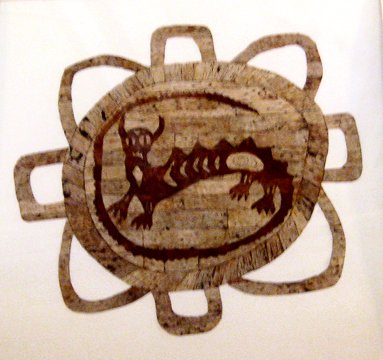 Mishipeshu With Horns By UyvsdiBy Uyvsdi - Own work, Public Domain, https://commons.wikimedia.org /w/index.php?curid=8843870 Shannon Dorey, Day of the Fish p.225 |
This picture of Mishipeshu, from the National Museum of the American Indian, George Gustav Heye Center library, shows him with horns, which was also a characteristic of the Nummo. Dionysus was likewise associated with a bull and the horns here resemble bull's horns. Another interesting factor is that Mishipeshu is known for guarding vast amounts of copper in Lake Superior and the Great Lakes Region. This is significant as it relates to the Nummo, who also mined copper in its liquid form, which was used in their spaceships. Ogotemmêli called it, "liquid copper".Dorey, Day of the Fish p. 220 I refer to the mining practice in this passage from The Master (Mistress) of Speech.
There is evidence that the Nummo used "liquid copper" for fuel and that they mined it over bodies of water: "The Nummo being, is in a sense, copper in virtue of his/her celestial and luminous essence, and takes back to himself/herself all copper that passes over watery places which are his/her preserves." Ogotemmêli said that rays falling from the clouds were changed into copper on touching the ground. "Not on the surface of the ground, however, but deep in the Earth, too deep for humans to be able to lay hold of it, the transformation took place."
Anyone wearing copper bracelets was warned to stay away from water, or they would risk being carried away by it, perhaps because of the process used by the Nummo to mine it. Ogotemmêli said, "To pass with the metal near certain waters was to risk seeing it return to the water and be carried away with it oneself."Shannon Dorey, The Master (Mistress) of Speech, p. 23
Taking copper from Lake Superior and the Great Lakes Region "was extremely taboo and forbidden by the Ojibwa. It was even worse to take it from the Great Lynx's home, Michipicoten Island; this was considered to be stealing from Mishipeshu himself."https://en.wikipedia.org/wiki/ Underwater_panther
A Jesuit missionary named Claude Dablon told a story about four Ojibwa men who went to the home of Mishipeshu to take some copper back to their home to heat water. The moment they pushed off, the eerie voice of the water panther surrounded them. The water panther came growling after them and "all four of the Indians [Indigenous men] died on the way back to their village; the last one surviving just long enough to tell the tale of what had happened in his final moments before he finally died."Dorey, Day of the Fish p. 221
It is quite possible that the Ojibwa men had been exposed to some type of nuclear radiation. Ogotemmêli also spoke about the death of those Dogon, who were attracted to the lake when this process was being carried out. Apparently the red calabash and glistening light associated with the Nummo spaceship attracted people to the lake and they were drawn into the water and drowned. In the Dogon culture copper was a symbol of the Nummo and was considered more important than gold.Shannon Dorey, The Master of Speech, p. 24
Because of these similarities, I believe that the chalk mounds found in England were created by the same people who built the chalk mounds in Ohio. If you would like to read more about the similarities between North American Indigenous cultures and the Dogon religion read this article North American Indigenous Myths and the Nummo Ancestors.
For more information on the Dogon religion refer to my books, The Master (Mistress) of Speech, The Nummo, Day of the Fish and The Rose.